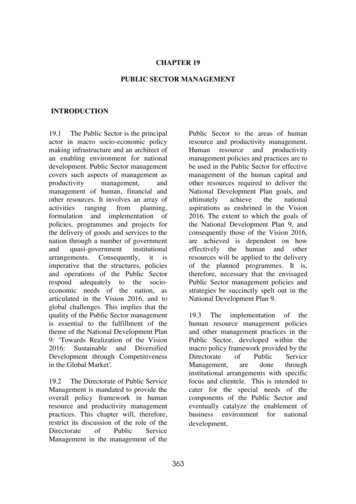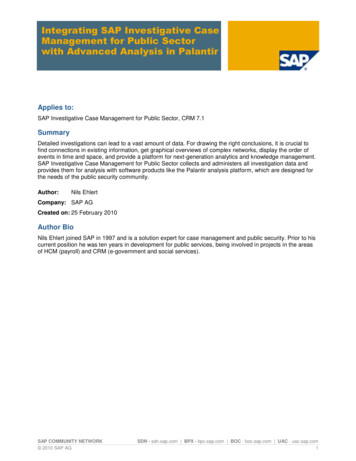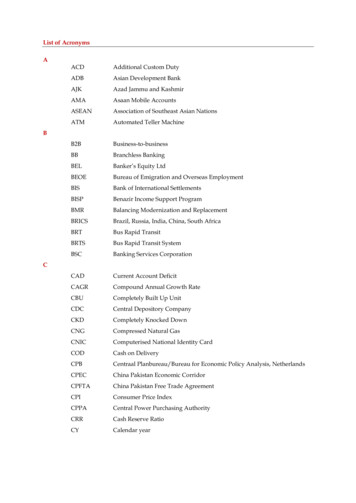
Transcription
CHAPTER 19PUBLIC SECTOR MANAGEMENTINTRODUCTIONPublic Sector to the areas of humanresource and productivity management.Human resource and productivitymanagement policies and practices are tobe used in the Public Sector for effectivemanagement of the human capital andother resources required to deliver theNational Development Plan goals, andultimatelyachievethenationalaspirations as enshrined in the Vision2016. The extent to which the goals ofthe National Development Plan 9, andconsequently those of the Vision 2016,are achieved is dependent on howeffectively the human and otherresources will be applied to the deliveryof the planned programmes. It is,therefore, necessary that the envisagedPublic Sector management policies andstrategies be succinctly spelt out in theNational Development Plan 9.19.1 The Public Sector is the principalactor in macro socio-economic policymaking infrastructure and an architect ofan enabling environment for nationaldevelopment. Public Sector managementcovers such aspects of management asproductivitymanagement,andmanagement of human, financial andother resources. It involves an array ofactivities ranging from planning,formulation and implementation ofpolicies, programmes and projects forthe delivery of goods and services to thenation through a number of ents. Consequently, it isimperative that the structures, policiesand operations of the Public Sectorrespond adequately to the socioeconomic needs of the nation, asarticulated in the Vision 2016, and toglobal challenges. This implies that thequality of the Public Sector managementis essential to the fulfillment of thetheme of the National Development Plan9: ‘Towards Realization of the Vision2016: Sustainable and DiversifiedDevelopment through Competitivenessin the Global Market’.19.3 The implementation of thehuman resource management policiesand other management practices in thePublic Sector, developed within themacro policy framework provided by oughinstitutional arrangements with specificfocus and clientele. This is intended tocater for the special needs of thecomponents of the Public Sector andeventually catalyze the enablement ofbusiness environment for nationaldevelopment.19.2 The Directorate of Public ServiceManagement is mandated to provide theoverall policy framework in humanresource and productivity managementpractices. This chapter will, therefore,restrict its discussion of the role of theDirectorateofPublicServiceManagement in the management of the363
Institutional Framework19.4 The institutional framework forthe Public Sector includes andindependent departments; parastatalorganizations; Department of LocalGovernmentServiceManagement(DLGSM), in the case of the Ministry ofLocal Government; and the TeachingService Management (TSM), in the caseof the Ministry of Education. Thedetailed mandates of these institutionsare given below.is covered under Chapter 15 on theMinistry of Education.Parastatal Sector19.7 The parastatal sector is part ofthe broader Public Sector and consists ofquasi-governmental organizations andgovernment agencies, many of whichwere created or established through Actsof Parliament. Parastatal organizationsexist to provide goods and services,which Central Government is not wellplaced to provide. Government holdsequity in most parastatal organizationsand is represented in the Boards that runthem.Local Government Service19.5 This is catered for by theDepartment of Local GovernmentService Management (DLGSM). TheDepartment has statutory responsibility,derived from the Local GovernmentService Act, for the formulation andadministration of human resourcemanagementpoliciesandotherconditions of service for the LocalAuthorities, within the general policyframework defined by the Directorate ofPublic Service Management. The reviewof the performance of the Departmentand the Local Authorities during theNDP 8 is covered under Chapter 20 onLocal Government.19.8 ganizations, which has a bearing onthe image of the public sector,Government has direct interest inensuring that they operate in a mannerthat satisfy their statutory ers.Consequently, theGovernment decided, during NDP 7, toestablishthePublicEnterprisesMonitoring Unit whose mandate, amongother responsibilities, is to analyze andadvise on the financial performance ofPublicEnterprisesandsuggestsmeasures for improving their efficiency.Government also passed a PrivatizationPolicy during NDP 8, which resulted inthe creation of the Public EnterprisesEvaluation and Privatization Agency(PEEPA). The objective of the policy isto enhance and improve the efficiency ofpublic enterprises.Teaching Service19.6 This is served by the TeachingService Management, which has astatutory responsibility, derived from theTeaching Service Act, for theformulation and administration of humanresource management policies and otherconditions of service for primary andsecondary school teachers. The reviewof the performance of the TeachingService Management during the NDP 819.9 Both the Public EnterprisesMonitoring Unit (PEMU) and the Public364
Enterprises Evaluation and PrivatizationAgency (PEEPA) being Governmentagencies responsible for the managementof the parastatal sector, are to managethe parastatal organizations based on thebroad management framework definedby the Directorate of Public ServiceManagement. The review of theperformance of parastatal organizationsduring NDP 8 is covered under thechapters of the ministries under whichthey fall.In carrying out its mandate, theDirectorateofPublicServiceManagement is also guided by itsVision, Mission, Values and StrategicPlan.Public Service19.11 TheDPSMalsohasresponsibility for Botswana Institute ofAdministration and Commerce, which islargely responsible for in-servicetraining in the Public Service, theBotswana National Productivity Centreand the Institute of DevelopmentManagement. These institutions are alsothe channels through which modernmanagement practices are introduced inthe Public Sector by way of building thecapacity of the public officers inmanagement and administrative skills.19.10 The Public Service consists of allministries and independent departmentsin Central Government. The DirectorateofPublicServiceManagement,however, has the statutory responsibilityfor administering the public service interms of the Public Service Act. TheDirectorateofPublicServiceManagement falls under the Ministry ofState President. Its principal role is tomanage and co-ordinate human resourceactivities in all government ministriesand departments.The ultimateobjectives are: To provide a stable, reliable andimpartial public service to thegovernment of the day; To increase the efficiency andeffectiveness of the government byproviding quality human resourceinput, so that the government’smultifarious services to the public,and its national developmentactivities are implemented;To effectively manage the publicservice within the framework ofgood service to the public, concernfor the welfare of employees,adherence to the Public Service Actand attainment of the national socialeconomic development objectives.19.12 As stated above, the review ofthe implementation of human resourcemanagement policies and modernmanagement practices and their impacton service delivery by the othercomponents of the Public Sector arecovered under respective ministerialchapters. Reviewed below, therefore, arethose policy areas, which were plannedfor implementation by the Directorate ofPublic Service Management eitherdirectly or through coordination of othersectoral interventions.365
REVIEW OF PERFORMANCE DURING NDP 8clarifying and aligning ministerial goals,objectivesandfunctionstoorganisational structures. WITS, on theother hand, is a strategy, which is used todetect and solve problems, resultingfrom implementation of policies andprogrammes.19.13 During National DevelopmentPlan 8, a number of initiatives wereundertaken to improve productivity andefficiency in the Public Service. Theseinitiatives included the introduction ofPublic Service Reform Programmes, aswell as improvement in human resourcemanagement policies and strategies. Thereview indicates what was planned forthe plan period, what was achievedunder each planned programme, thechallenges that were faced during theimplementation of the programmes andthose aspects of the planned programmesto be carried forward for implementationduring the National Development Plan 9.i) Performance Management Systems19.14 The Public Service ReformProgrammesincludesPerformanceManagement System (PMS); WorkImprovementTeams(WITS);Computerized Personnel ManagementSystem (CPMS); Organization andMethods(O&M);Privatization;Performance Based Reward System(PBRS); Parallel Progression; ScarceSkills; Job evaluation; Localization; andDecentralization.19.16 The system is intended tofacilitatetheintroductionandmanagement of change in ministries anddepartments, as well as instil a culture ofmanaging performance and producingresults as expected by the nation. Itsmain objectives are to improveindividualandorganisationalperformance in a systematic andsustainable way; to provide a ministerialplanning and change managementframework that is linked to theGovernment planning and budgetingprocesses; and to enable Government toimprove performance and enhance itscapacity to provide efficient servicedelivery to Batswana. PMS is, therefore,a strategy that helps ministries andindependent departments to define theirfuture and design how to reach thedesired destination.19.15 The functions of the PerformanceManagement System, Organisation andMethodsReviewsandWorkImprovement Teams are different butcomplementary strategies aimed atimproving productivity in the PublicService. Whereas PMS is primarilyconcerned with the formulation andimplementation of short to long-termplans for improving productivity, O&MReviews are aimed at the achievement ofGovernment plans and policies by19.17 The Performance ManagementSystem was introduced in all ministriesand departments during NDP 8, througha five-year project, which started in1999, and ends in 2004. The mainactivity was the installation of theSystem, which comprised training thepublic service leadership on PMS andchange management, development of thepublic service vision, ministerial visionstatements and strategic plans, and thedevelopment of annual performanceThe Public Service ReformProgramme366
review of the performance appraisalinstrument and mid-term evaluation ofthe PMS project. The process ofintroducing PMS to Local Authorities,which is considered to have greaterimpact on overall government servicedelivery, has been started and will takemost part of NDP 9. The development ofperformance based reward system;performance contract and review ofperformance appraisal instruments havealso started and are to be completedbefore the end of NDP 8. Mid-termevaluation of the PMS project has beenundertaken. The result of the evaluation,which was conducted after two and halfyears into the implementation of theproject, indicated that the project isgenerally well on course. However, anumber of recommendations were madeto facilitate effective and focusedimplementation of the project. Therecommendations have been accepted bythe government and have beenprogrammed for implementation fromnow through to NDP 9.plans (APPs) to deliver the strategies.To date, all ministries and independentdepartments have developed theirstrategic plans and annual performanceplans (APPs).19.18 To effectively manage theirstrategicplans,ministriesandindependent departments are to measuretheir performance and review theirprogress quarterly. Most ministries andindependent departments carry outquarterly reviews. However, most ofthem have not been able to measure theirperformanceusingthestandardmeasurement tools. The problem hasbeen identified and addressed andministries are to start measuring theirperformance to support their reviewsfrom now through to NDP 9 period.19.19 Ministriesandindependentdepartments were also required tocascade PMS philosophy and principlesdown to the lowest levels, afterdeveloping their corporate strategic andannual performance plans, to enabletheir staff to understand, appreciate andsupport PMS initiatives. The rate ofcascading PMS has varied from oneorganization to another, depending ontheir capacity to undertake this.However, in the majority of cases,education and PMS awareness has noteffectively reached the staff at themiddle and lower levels of theministries. The cascading process isscheduled for completion during NDP 9,while the education process willcontinue throughout the project period.19.21 The major challenge faced duringthe implementation of PMS was theentrenched paradigms among someleaders, which tended not to support theintroduction of PMS in ministries. PMSwas viewed by such leaders as anotherprogramme destined to fail. This sloweddown the implementation of theprogramme. The other major challengewas the difficulty that ministries facedgenerally with the application of themeasurement tools. This has beenaddressed and it is hoped that ministrieswill be able to apply the tools from nowonwards. However facilitating ministriesin the use of measurement tools willcontinue during NDP 9.19.20 Other PMS activities planned forimplementation during the NDP 8include introduction of PMS to LocalAuthorities,developmentofPerformance based reward system,367
19.25 The Commonwealth Secretariatevaluated WITS programme in 1998 andvaluable recommendations were madefor its improvement. Since then therehave been signs of positive work culture,commitment to work and concern forcustomers’ needs, which is e volving inthose ministries and departments thathave taken WITS seriously. Forinstance, the impact of the application ofWITS principles has been remarkable atthe Botswana Police Force as evidencedby public acknowledgement of thequality of their service delivery. Theapplication of WITS principles toimprove service delivery by ministriesand independent departments will bepromoted vigorously during NDP 9period. To ensure that WITS iseffectively used in the Public Service,more focus will be put on monitoring itsimpact on service delivery.19.22 The other big challenge is thepublic expectation for better servicedelivery by the Public Service since theintroduction of PMS. This expectationhas not been met and it is the concern ofthe government that reasonable progressis made during NDP 9. The introductionof PMS at the Local Authority level andthe decision by ministries to concentrateservice delivery on key priority areasamong other strategies will help toaddress this concern.ii) Work Improvement Teams19.23 TheWITSstrategywasintroduced in the Public Service in 1993.The strategy seeks to foster team spirit,commitment to work and a mindset thatseeks excellence. It is one of thestrategies used in PMS to facilitate theidentification and solution of problemsat the operational level in ministries andindependent departments.19.26 The introduction of PMS posed aserious conceptual challenge to WITSbecause it was generally believed thatPMS would replace WITS. This wasbased on the misunderstanding of thefunctional relationship between the tworeform strategies. WITS and PMS aretwo sides of the same coin and as such adecision has been made to integrate themso that the two strategies can be usedeffectively to achieve the bestperformance result for the organizations.19.24 Training of WITS members,together with the execution of projectscontinued during NDP 8. To date, 565facilitators and well over 2,500 teamleaders have been trained. More thansixteen WITS awareness sessions havebeen held for top managers, while 1,000teams have been registered compared tothe planned 1150. Over 700 projectshave been undertaken of which morethan 400 have been completed. As a wayof publicizing the WITS programme andthe benefits it can bring, a nationalconvention has been held annually forthe past five years. The annual event hasalso been used to reflect on the progressmade and challenges encountered in theimplementation of WITS during the yearunder review.iii) Computerisation of PersonnelManagement Systems19.27 In 1997, the Directorate of PublicService Management embarked on thecomputerisation of all the personnelrecords and posts in the Public ServicethroughtheComputerisationofPersonnel Management System (CPMS)Project.The project involves the368
installationofhumanresourcesapplications and it comprises fourdifferent phases, namely:θθθθmeasures in place to address theseproblems.19.30 TheTeachingServiceManagement, the Botswana PoliceService and the Local Authorities arealso computerising their human resourcemanagement systems. As a long-termstrategy to ensure the sustainability ofthe systems, in terms of maintenance andoperational costs and to ensuremaintenance of data-quality, thedepartments are co-operating with theAccountant General to develop a systeminterlinking the payroll and the humanresource management systems.Pilot PhaseRoll-out PhaseEnablement Phase andEnrichment Phase19.28 The pilot and roll out phaseshave been completed. Work has startedon the Enablement Phase and willcontinue into NDP 9. The completion ofthe roll out of the system has resulted inthe establishment of a core humanresource management system in everyministry and independent department.Each Human Resource Officer ingovernment now has a PersonalComputer (PC) connected via theGovernment Data Network (GDN) to theComputerised Personnel ManagementSystem. Approximately 400 HumanResource Officers in ministries andindependent departments have beentrained in the use of the Lotus Notes email, Infinium Human Resource systemand the online DPSM policy database.iv) Organisation and Methods (O&M)19.31 Organisational reviews are usedto align ministerial goals, objectives andfunctions with its vision and mission anddetermine the core functions of aministry, thereby facilitating theidentification of functions to beconsideredforprivatisation,commercialisation and contracting out. Italso involves the review of ministerialpolicies and procedures and reengineering of its processes to facilitateeffective implementation of its mandate.It, therefore, facilitates effectivemanagement of organizations throughrationalisation of their organisationalstructures.This function supportsPerformanceManagementSystembecause it provides an enablingenvironment for its implementation.19.29 Despite the progress made so far,difficulties continue to be encountered inthe usage of the Computerised PersonnelManagement System. Some ministriesdo not regularly update data on thesystem with all the changes taking place.This affects the quality of data.Ownership of the system by ministries isstill a challenge and DPSM iscontinually encouraging them to takefull responsibility for the ownership ofthe information and the system. Therehave also been some instances whereofficers who were trained and re-trainedon the system have been assigned otherduties thus affecting the management ofthe system. DPSM has put appropriate19.32 A review of overall governmentportfolio responsibilities was undertakenduring NDP 8. The purpose of thereview was to identify, rationalise andregroup related sectoral portfolioresponsibilities as well as eliminateduplications and overlaps of government369
portfolioresponsibilitiesacrossministries. In addition, O&M reviewswere conducted and finalised duringNDP 8 for the following institutions:Administration of Justice; Ministry ofForeign Affairs and InternationalCooperation; Student Career Services;Grants and Loans; UNESCO; SocialServices; Prisons and Rehabilitation;Government Aided Training Institutions(BIAC); Ministry of Trade and Industry;National Registration; Lands andHousing, Environment, Wildlife andTourism; and Labour and SocialSecurity.19.35 The impact of past O&M reviewson the performance of ministries anddepartments has not been evaluatedowing to the absence of a propermonitoring and evaluation mechanism.FollowingO&Mreviews,mostministries tended to implement onlythose recommendations that would givethem more resources, particularly moreposts, at the expense of other equallyimportantrecommendations,thusaffecting the intended result of thereviews.19.33 Work is currently in progress onthe O&M reviews of theMinistriesand Departments of Local Government,Agriculture, Health, Directorate ofPublic Service Management, Office ofthe President, Health, Architecture andBuilding Services and Electrical andMechanical Services. Work is about tostart on the O&M review of theDepartments of the Auditor General andAttorney General’s Chambers. All thesereviews are to be completed during NDP8. More reviews will be carried outduring NDP 9 as most ministries andindependent departments align theirstructures and functions to their mission.19.36 The government embarked onprivatisation so as to improve productivityand efficiency in the delivery of services bythe public sector. Privatisation entailsdivesting non-core functions to the privatesector, while Government remains with theresponsibility to provide an enablingenvironment, infrastructure and essentialservices like health, education and transport.v) Privatisation19.37 The contribution of the Directorateof Public Service Management to theprivatisation policy goals is through itsinvolvement in the implementation of PMSstrategy and O&M reviews of ministries andindependent departments. PMS strategy andO&M help ministries and independentdepartments to establish their core businessand identify those functions which can beconsideredforprivatisation,commercialisation and outsourcing.19.34 Due to increased demand forrestructuringbyministriesanddepartments and capacity constraints, theDirectorate has allowed ministries anddepartmentstoengageprivatemanagement consultants. To facilitatethis, the Directorate has developedcomprehensive guidelines for themanagement and monitoring of privatemanagement consultants in order toensure value for money to government.vi) Performance Based Reward System(PBRS)19.38 Performance Based RewardSystem (PBRS) is intended to linkindividual employee performance torewards so as to facilitate retention ofgoodofficers,encouragegoodperformance, and discourage poor ornon-performance.Workonthe370
development of PBRS is scheduled forcompletion before the end of NDP 8,while the actual implementation of thesystem will be done during NDP 9.(b) In the past three years, theeconomy has been losing skilledmanpower through death.This has resulted in situations whereGovernment is compelled to recruitexpatriates,thusworseningthelocalisation situation.vii) Performance Contract19.39 Thedevelopmentandimplementation of PBRS is intended tofacilitate the introduction of performancecontract for senior officers in the PublicService. The implication of this will bethat employment in the Public Servicefor this category of employees will bebased purely on performance anddelivery as per their contract. Thedevelopment of performance contractsystem will be concluded during theNDP 8 and implemented during NDP 9.19.42 The focus of training during theNDP 8 has been to redirect the placement oftrainees to in-country training and the regionin order to reduce the costs of training toGovernment and provide training for morepublic officers. This strategy will continueto be pursued during NDP 9.x) Decentralisation of Human ResourceManagement Functions19.43 Decentralisationofhumanresource management functions from theDirectorateofPublicServiceManagement (DPSM) to ministries wasanother reform implemented duringNDP 8.It covered human resourcefunctions for posts up to D1 level. Theprimary objective of the decentralisationwas to give Permanent Secretaries fullcontrol on all matters relating to themanagement of human resource in theirministries. This has enhanced effectiveand timely decision making on staffmatters at ministry level. An evaluationof the impact of the decentralizationprocess will be done during NDP 9.viii) Performance Appraisal19.40 For effective management ofperformance based reward system andperformance contract, an appropriateperformance appraisal instrument isrequired. The current performanceappraisal instrument is being revised tofacilitate this. The revision will becompleted during the NDP 8, while itsimplementation will be done duringNDP 9.ix) Training and Localisation19.41 Localisationtargetshavecontinued to be difficult to meet duringNDP 8. The reasons for this are that:xi) Decentralization of other functions19.44 ToempowerPermanentSecretaries to effectively deliver on theirstrategic plans, it was resolved by theProductivity Improvement Committee(PIC Force) that certain functions of theMinistry of Finance and DevelopmentPlanning; Ministry of Works, Transportand Communication; State President;(a) Government continues to loseskilled and educated manpowerto other sectors of the economy,which offer higher remunerationpackages than government; and371
Ministry of Lands and Housing, Ministryof Environment, Wildlife and Tourism;Ministry of Labour and Home affairs;and Attorney General Chambers bedecentralized to other ministries anddepartments. It is anticipated that theenvisaged decentralization will startbefore the end of the NDP 8 andcontinue during NDP 9.inconsistencies in the implementation ofthe scheme, which distorted the PublicService salary structure. For example, itexcluded other cadres that qualifiedwhile including some that should nothave qualified. This caused widespreaddisgruntlement amongst public officers,and in some instances, litigation againstGovernment.xii) Parallel Progression Scheme19.48 In view of the problemsencountered, Government decided toabolish the scarce skills grades andreplace it with a scarcity allowance. Ascarce skill compensation scheme, whichwill have a firm criterion for determiningoccupations in the Public Service thatshould attract payment of scarcityallowance as well as the rates to be paidas scarcity allowance will be developed.The process to establish the scheme hasstarted and will be implemented duringNDP 919.45 The parallel progression schemewas introduced during NDP 7. Itsobjective was to improve careerprospects for Artisans, Technicians andProfessionals and retain them in theService.A review was undertakenduring the NDP 8 to establish whetherthe Scheme met its primary objective ornot, following which Governmentdecided to abolish the upgrading of postsunder which officers used to beautomatically promoted. However, thesalary structures developed under theparallel progression scheme have beenretained as they offer better careerprogression paths for technical andprofessional cadres.xiv) Job Evaluation19.49 Government introduced a JobEvaluation System called PattersonDecision Band System in 1988. Thesystem uses decision making to measurethe relative responsibilities of jobs.xiii) Scarce Skills Grades Scheme19.46 Government took a decision in1998 to introduce scarce skills grades inthe Public Service. The introduction ofthe scarce skill grades was in recognitionof the need to attract and retain localpersonnel with certain critical and rareskills.19.50 The Job Evaluation System hasnot been evaluated since its introductionto determine its strengths andweaknesses. Government has, therefore,decided that the system be evaluated todetermine its relevance in view of thedevelopments that have taken place overtime. This will be commenced during theNDP 8 and completed during the courseof NDP 9.19.47 However, the introduction of thescheme overlooked certain criticalfactors in the determination of scarceskill grades and the identification ofcadres that were to benefit from thosegrades. This resulted in many19.51 The 1998 Salaries ReviewCommission and a consultancy that wascommissioned in 2001 to review the372
salaries and allowances in the PublicService recommended the establishmentof a pay structure peculiar to theBotswana Police Service. In addition,the Consultancy recommended theinclusion of Botswana Prisons Service,Teaching and Health Services in thereview. It also recommended the reviewof the job evaluation system currentlybeing used in the Public Service.educational facilities and other socialamenities.19.55 The major challenge with theimplementation of RASA is that theparameters that were established at thebeginning of the Scheme may no longerbe relevant or appropriate. The policywill, therefore, be reviewed during theNDP 8 to establish the appropriatenessof the parameters or the relevance ofRASA in view of the developments inthe areas of the country that used toattract RASA.19.52 The process of establishing a paystructure for the Botswana PoliceService, Botswana Prisons Service,Health service personnel, and teachers isin progress and is scheduled forcompletion before the end of NDP 8.ii) Public Officers Pension Scheme19.53 These policies include those onRemote Area Service Allowance; PublicOfficers Pension Scheme; Early Exit;and Industrial and Employee Relations.These policies were reviewed in aneffort to produce human resourcemanagement policies that wouldfacilitate the attraction and retention ofqualified and competent public officers.19.56 The Botswana Public OfficersPension Fund commenced on the 1stApril 2001. Government contributes17.5% whilst Public Officers 2.5% forthe first two years, i.e. up to 31st March,2003. From 1st April 2003 Governmentwill contribute 15% whilst PublicOfficers contribute 5%. The schemecovers the whole Public Service,including Central Government, LocalAuthorities, Teaching Service, BotswanaDefence Force, Botswana Police Serviceand Botswana Prisons Service. Themembership of the Scheme stood at21633 as at 1st April 2002.i) Remote Area Service Allowanceiii) Early Exit PolicyHUMAN RESOURCEMANAGEMENT ANDDEVELOPMENT POLICI
Public Sector management policies and strategies be succinctly spelt out in the National Development Plan 9. 19.3 The implementation of the human resource management policies and other management practices in the Public Sector, developed within the macro policy framework provided by the Directorate of Public










